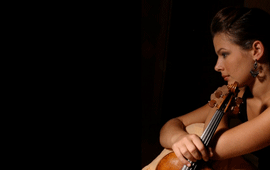> [Archived] Interviews

'Octet for Strings in C major' by George Enescu at the Lincoln Center for the Performing Arts - twice in one day
We talked to violinist Bella Hristova, one of the performers, and asked her how she came to know Enescu's 'Octet'.
Bella Hristova: The piece was chosen by the Chamber Music Society of the Lincoln Center; I have never heard it before it was scheduled to be played in our recital, but while performing it I just fell in love with it, it became my new favourite piece. It is a piece of considerable proportions; each instrument has an important, responsible position; it is an octet in which all voices work together, it is a pleasure to perform it even in those moments of accompaniment. That is why, we have loved it so much. It is a fairly long piece, and its four movements are played without interruption, they are connected, intertwined, thus one can view it as a single part of a giant symphony. The score is very ample, very much suited for the orchestra. It was very challenging and pleasing to decipher it, even more so to perform it, in those two consecutive concerts.
Many of Enescu's pieces have detailed directions on how to play it; is it the same with the 'Octet', Bella Hristova?
Yes, but not so much as with the 'Violin Sonata No. 3 in A minor', for example. Here the detailed directions are about the tempo in which we have to play it, while with the Sonata, Enescu wrote on the score including the improvisations that the instrumental performers have to make. I do not feel restricted by these permanent guidelines - even if they are there, I will inevitably have my own style of performing it, different from others, and this is my freedom.
Am I to understand that you are familiar with the 'Violin Sonata No. 3 in A minor'?
Yes, I heard it performed, I have not played it myself but it is on my to-do list! I would love to discover more of Enescu's music, not just the one for violin, but also for other instruments, because I find it extraordinary. I believe that people are unfamiliar with his work and this is truly a loss.
Translated by Florina Sămulescu
MTTLC, Bucharest University














